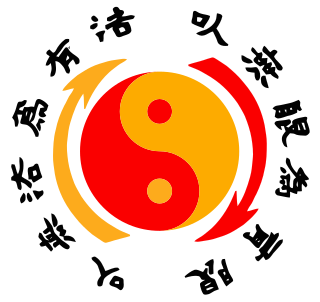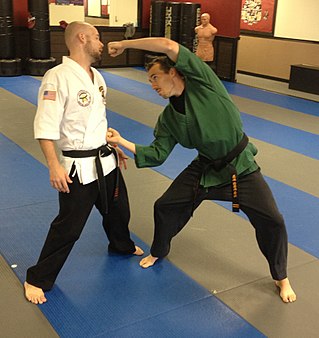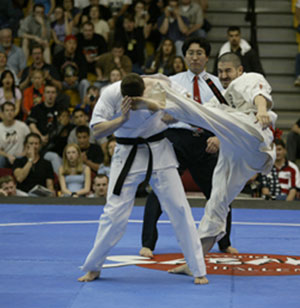
Jeet Kune Do is a hybrid martial art conceived and practiced by martial artist Bruce Lee. It was formed from Lee's experiences in unarmed fighting and self-defense—as well as eclectic, Zen Buddhist and Taoist philosophies—as a new school of martial arts thought.
Kajukenbo is a hybrid martial art from Hawaii. It was developed in the late 1940s and founded in 1947 in the Palama Settlement on Oahu, Territory of Hawaii.

American Kenpo Karate, also known as American Kenpo or Ed Parker's Kenpo Karate, is an American martial art, founded and codified by Ed Parker. It is synthesized mainly from Japanese and Okinawan martial arts such as karate and judo, with influence from Chinese martial arts.
The following outline is provided as an overview of and topical guide to martial arts:

Count Juan Raphael Dante was an American martial artist figure during the 1960s and 1970s who claimed he could do extraordinary feats such as Dim Mak.
Ted Wong was a martial arts practitioner best known for studying under Bruce Lee.

Black Belt Jones is a 1974 American blaxploitation martial arts film directed by Robert Clouse and starring Jim Kelly and Gloria Hendry. The film is a spiritual successor to Clouse's prior film Enter the Dragon, in which Kelly had a supporting role. Here, Kelly features in his first starring role as the eponymous character, a local hero who fights the Mafia and a local drug dealer threatening his friend's dojo.
The Long Beach International Karate Championships is an International karate and martial arts tournament in Long Beach, California that was first held in August 1964 by Kenpo Grandmaster Ed Parker. The tournament ran competition til 1999 under IKKA organization/Parker family. Many great tournament fighters earned their stripes at this tournament, including Chuck Norris, Andy Ah Po, Tony Martinez Sr., Mike Stone, Joe Lewis, Jim Kelly, Benny "The Jet" Urquidez, Billy Blanks, Jerry Piddington, and "Superfoot" Bill Wallace. The Long Beach Internationals is also where Bruce Lee was first introduced to the martial arts community in August 1964, with Lee making another appearance in 1967.

Joe Lewis was an American martial artist, professional kickboxer and actor. Originally a practitioner of Shōrin-ryū karate and champion in point sparring competitions, he became one of the fathers of full contact karate and kickboxing in the United States, and is credited with popularizing the combat sport in North America.
The Journal of Asian Martial Arts (JAMA) was a quarterly magazine published by Via Media Publishing Company that covered various aspects of martial arts from Asia, but also included material from other parts of the world. The magazine had its headquarters in Santa Fe. It ceased publication in 2012, ending with a final book entitled "Asian Martial Arts".

Bruce Lee's Fighting Method is a book of volumes covering Bruce Lee's martial arts abilities of the Jeet Kune Do movement. The book is available as a single hardcover volume or a series of four paperback volumes. The text describes Bruce Lee's Kung Fu fighting techniques, philosophy and training methods. This book was originally written in 1966 by Bruce Lee. However, Lee decided not to publish this work as he feared that instructors would use the fighting knowledge in this text to promote themselves. In 1978, after Bruce Lee's death, his widow Linda Lee Cadwell decided to make available the information on her husband's work. Lee's death changed the perspective of releasing the information that Bruce Lee himself had vacillated about. The book was published with the help of Mitoshi Uyehara. Uyehara was the founder and owner of Black Belt Magazine. During the early years of the publication, Uyehara served as the publisher. Bruce Lee contributed many articles to the publication during the 1960s and a friendship ensued between the two men. Uyehara, a martial artist in his own right, was a key personage in arranging Lee's material for publication.
Tae Kwon Do Times is a magazine devoted to the martial art of taekwondo, and is published in the United States of America. While the title suggests that it focuses on taekwondo exclusively, the magazine also covers other Korean martial arts. Tae Kwon Do Times has published articles by a wide range of authors, including He-Young Kimm, Thomas Kurz, Scott Shaw, and Mark Van Schuyver.
The Bruce Lee Library is composed of books written by or about Bruce Lee (1940-1973), famous Hongkongese and American martial artist, philosopher, author, instructor of martial arts, actor, filmmaker and screenwriter.
Adriano Directo Emperado was one of five martial artists who developed the kajukenbo self-defense system.

Kokusai Budoin, International Martial Arts Federation (IMAF) is the oldest continuously operating Japanese organization promoting international Budō. The organization, founded in 1952, has headquarters in Tokyo, Japan and is a member of the United Nations Department of Economic and Social Affairs.
Takayuki Kubota, also known as Tak Kubota, is a Japanese-American karateka, known as the founder the Gosoku-ryu style of karate. He holds the title of sōke (grandmaster) for his development of the Gosoku-ryū, and is the founder and president of the International Karate Association. He is also the inventor and holder of the trademark of the Kubotan self-defense key chain.
Aaron Banks was a martial artist born in Bronx, New York. He brought Chinese Kung Fu, Korean Moo Duk Kwan, Japanese and Okinawan Goju-Ryu karate, judo and boxing under the same roof in his New York Karate Academy. During his life, he promoted 352 karate tournaments, conducted more than 1,000 demonstrations, and organized over 250 martial arts shows. His karate influence can be seen through his karate school which he operated for 30 years and the 200,000 or more students he taught. Aaron Banks also brought martial arts to the public with his "Oriental World of Self-Defense" shows that played in Madison Square Garden for over 20 years via ABC-Wide World of Sports, NBC Sports world, CBS sports, and HBO sports, where millions of viewers watched.

Active Interest Media (AIM) is a publisher specializing in "niche enthusiast magazines".

Karate was first introduced to American service men after World War II by Japanese and Okinawan karate masters.
Karaté Bushido is a French magazine who publishes martial arts stories from around the world. The magazine was founded in 1974, a few months after the death of Bruce Lee. The magazine is also the organizer and founder of the world renowned Festival des Arts Martiaux since 1985.









